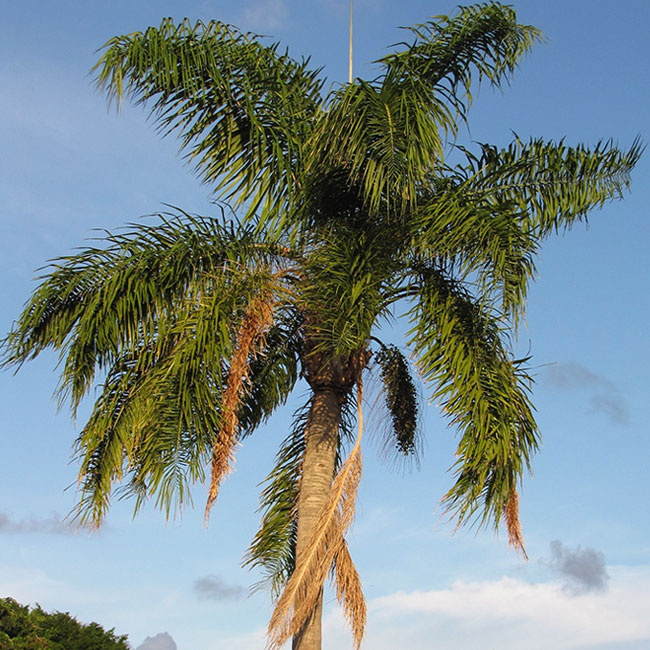
The Queen Palm Tree, scientifically known as Syagrus romanzoffiana, is a widely cherished palm in tropical and subtropical climates due to its stunning appearance and low maintenance requirements. Moreover, it is both cost-effective and readily available for purchase.
You can spot hundreds of thousands of these palms adorning communities in California and Gulf States. Its popularity can be attributed to its impressive height and rapid growth rate.
The Queen Palm is indigenous to southern Brazil, northern Argentina, Uruguay, and Paraguay, where it typically thrives in small mountain ranges and lowland areas.
If you’re in search of a fast-growing palm that reaches great heights, is sturdy, budget-friendly, and easy to acquire, the Queen Palm is an excellent choice.
Quick Facts:
| Scientific name: | Syagrus romanzoffiana |
| Common names: | Queen Palm, Cocos Plumosa, Jeriva Syagrus romanzoffiana. |
| Origin: | Native to the South American woodlands of Brazil and Argentina. |
| Growth Rate: | Fast. Up to 30 – 40 ft and 5 -10 ft wide. |
| Cold Tolerance: | USDA Zones 9b (25 to 30 F) to 11 (above 40 F). |
| Light Req: | Partial shade to Full sun. |
| Water Req: | Moderate. |
| Soil Req: | Slightly acid best, but fairly adaptable. |
| Fruit: | Yes. Yellow to orange |
| Propagation: | By seeds, germinating in 3-6 months. |
Queen Palm Appearance
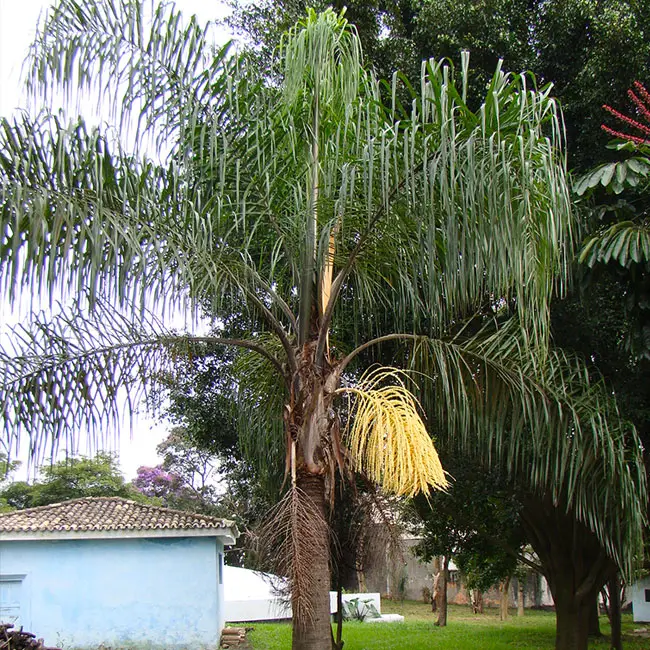
Syagrus romanzoffiana features a smooth single trunk adorned with leaf scars and crowned with dark green, feathery fronds. Its pinnate, feather-like leaves tend to grow more upwards than outwards.
With regular fertilization, this plant can reach a maximum height of about 30 to 40 feet and span 5 to 10 feet in width. In fact, I’ve even seen specimens that reached an impressive 60 feet. It achieves a growth rate of around 6 feet per year after establishing itself.
The leaf stem measures about 5 to 15 feet in length and boasts double rows of leaflets, with each leaflet blade spanning approximately 18 to 36 inches. The trunk can attain a diameter of nearly 2 feet.
Since this palm doesn’t naturally shed old fronds, it’s necessary to manually remove the brown ones; otherwise, they will hang down, detracting from the tree’s aesthetic appeal.
Queen Palm Flowers and Fruits
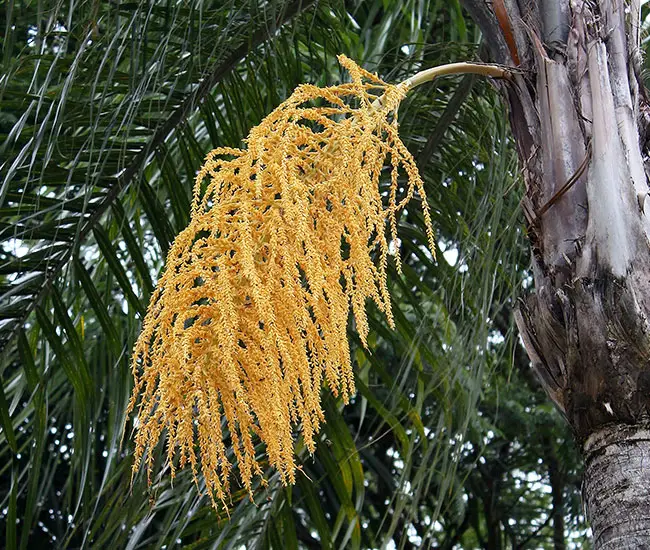
During the summer months, the Queen Palm will delight you with lovely clusters of creamy flowers on a green stalk that emerges beneath its leaves. In early winter, green fruits appear, gradually turning orange as they mature.
These fruits, often referred to as “dates,” are round in shape and about 1 inch long, each containing a single seed. While the fruit emits a pleasant fragrance, it is not fit for consumption. However, it is non-toxic to both humans and pets, and you may even spot squirrels enjoying these fruits.
When the dates fall to the ground, they can create sticky piles of decaying fruit that attract insects.
While there isn’t a chemical solution to prevent the tree from producing seeds, you can nip the issue in the bud by removing the flowers when they first appear. This is the simplest way to prevent the fruit from dropping.
How To Care For Queen Palm
The Queen Palm exhibits rapid growth even from the seedling stage, reaching a height of 6 feet in just two to three years when provided with the right environment. This is why it’s readily available and quite affordable.
It thrives in acidic to neutral soil with good drainage, as it may suffer from manganese deficiency in alkaline soils. While it does have some tolerance for drought, it appreciates regular watering and exhibits moderate salt tolerance.
Though it can maintain an attractive appearance even when neglected, it truly shines when provided with ample fertilizer and water. It thrives in full sun but can also tolerate light shade.
It’s worth noting that the Queen Palm has a shallow root base and is known for being susceptible to falling during high winds and hurricanes.
Light
A spot with full sun is ideal for the Queen Palm, unless you are planting it in extremely hot inland or desert areas. In such cases, filtered light or partial shade is necessary to prevent leaf burn.
The high light requirement is one of the reasons why the Queen Palm is not well-suited as an indoor plant.
Soil
In California, many Queen Palms thrive in dense clay soil. Although they can adapt to various soil types, they flourish in slightly acidic soil with some organic material.
Alkaline soils may lead to a manganese deficiency, resulting in a condition known as “frizzletop.” Like most palms, they require good drainage and dislike soggy soil.
To enhance drainage, consider adding sand to the soil mix when planting this palm. Soil mixes based on Canadian peat moss are favored by many gardeners.
This palm is relatively weak-rooted and can be easily transplanted when young. Mature plants are rarely uprooted due to the high cost and labor involved. It is often more cost-effective to purchase a new large plant rather than relocate an older one.
Watering Queen Palm
In addition to proper feeding, correct watering is crucial for the healthy growth of Queen Palms. Newly planted specimens should be watered daily for the first week, every other day during the second week, and approximately three times a week thereafter. Established Queen Palms typically require watering 2-3 times a week, with adjustments based on the season.
Since these palms exhibit more growth during warm months, they need more water in the summer and less in the winter when their growth rate slows down. During colder months, watering once a week should suffice.
The amount of water needed generally depends on soil type and drainage, but here’s a handy rule of thumb for watering palms: provide 10-20% of the container’s size in water.
For example, if you have a 10-gallon palm, use 1 gallon of water; for a 20-gallon palm, use 2 gallons. Even if your palm is planted in the ground, you can estimate the container size required for that palm.
Always check the soil to ensure it’s adequately moist and adjust your watering accordingly. In the summer months, use slightly more water, and in the winter, a bit less.
To check soil moisture, you can use a soil probe or a moisture meter. Alternatively, a screwdriver can serve the same purpose. Insert the soil probe or screwdriver as deeply as possible into the ground, twist it, and then withdraw it.
If the soil is too dry, the probe will stop, and you can feel the soil to determine its moisture level. Avoid watering deeper than the root depth, as the roots cannot access water below that point.
Fertilizing Queen Palm
Queen palms require a fertilizer containing essential minerals, such as magnesium, iron, copper, manganese, and nitrogen.
To prevent nutritional deficiencies, it is advisable to use a high-quality palm fertilizer with a continuous-release formula, applying it twice a year during the growing season.
Queen palms have a particular need for manganese to support healthy growth, which should not be confused with magnesium. Therefore, even after using a standard fertilizer containing manganese, it’s wise to supplement the soil with additional manganese.
Manganese deficiency often leads to the development of a “frizzy top,” a common issue observed in many Florida queen palms. Unfortunately, many homeowners are unsure of the proper fertilization regimen, which can lead to this condition. If you notice symptoms of “frizzy top” developing, it’s crucial to address it promptly by adding more manganese to the soil.
I recommend using a 10-5-10 slow-release formula for fertilization. Slow-release fertilizer provides nutrients to your palm over several months without risking root burn, a common cause of palm tree mortality.
Look for a 10-5-10 fertilizer that includes various micronutrients, ideally containing at least six of the following: Magnesium, Manganese, Sulfur, Boron, Copper, Iron, and Zinc.
Avoid purchasing cheap fertilizer in an attempt to save money, as it may contain lower-quality nutrients for your palm. Similarly, don’t make your choice based solely on a brand name. One of the most valuable pieces of advice is to always read the label, and remember that the best fertilizer is typically not inexpensive.
Note: When applying fertilizer, ensure it is placed at least 2 feet away from the base of the queen palm trunk to prevent damage to the trunk. Apply the fertilizer before watering, not after.
Temperature
In general, Syagrus romanzoffiana can tolerate cold temperatures down to 25°F when mature. Some palm enthusiasts have reported that it can withstand temperatures as low as 18°F without suffering permanent damage. However, expect some leaf damage when temperatures drop below 25°F, with complete defoliation occurring at approximately 20°F.
This palm species is well-suited for USDA Zones 9b (25 to 30°F) to 11 (above 40°F). Growing it outside of Zone 9b may pose challenges and necessitate cold protection measures. If you don’t mind full defoliation during the winter months, it might still be a viable option.
If you appreciate the appearance of the queen palm but require a more cold-tolerant species, consider exploring some queen palm hybrids. For instance, the Mule Palm (Butiagrus nabonnandii) is a hybrid between the Pindo Palm and Queen Palm.
While it may be somewhat more expensive and harder to find, it offers increased cold tolerance, enduring temperatures as low as 20°F.
Pruning Queen Palm
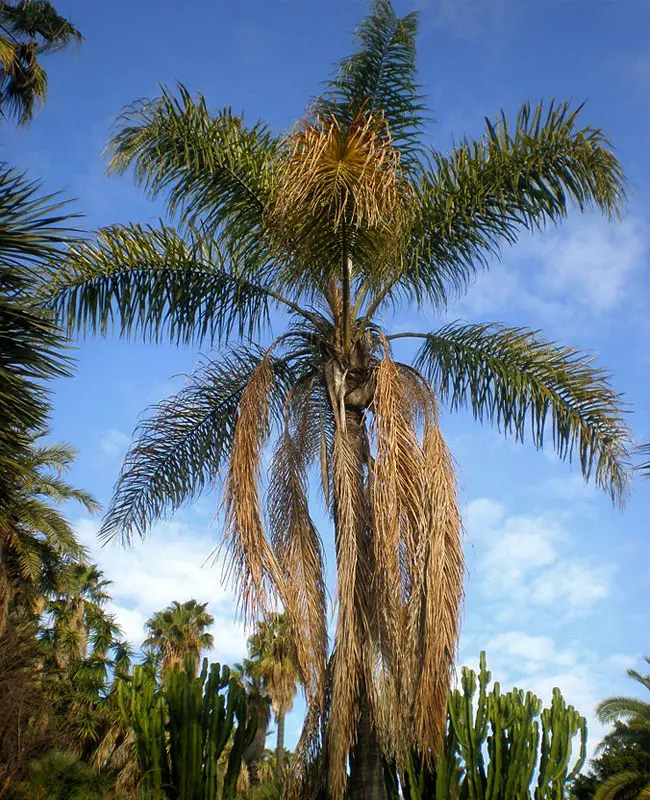
This palm requires some pruning of old leaves since it is not “self-cleaning.” While it’s not mandatory to trim the leaves, it can take a considerable amount of time before they naturally drop off.
Manual pruning significantly improves the tree’s appearance, and it’s essential for safety reasons as dropping leaves can potentially hit people or cars.
The ideal time for pruning is from September to the beginning of November. During this period, you can remove old fronds that have been damaged over the summer using a saw. Focus on eliminating only the minimum amount of fronds that have turned yellow or brown.
Excessive pruning can weaken the palm and impede its growth. For tall queen palms, a ladder may be necessary to reach dry fronds. If you reside in Florida, it’s relatively easy to find a company that can handle this task for you.
Queen Palm Insects and Diseases
The primary pests that pose problems for queen palms are the palm leaf skeletonizer and scale insects.
Queen Palms are susceptible to Ganoderma butt rot, a disease that can be fatal for the palm. Unfortunately, there is no cure for this condition, and the only recourse is to implement preventative treatments.
Queen Palm Propagation
Propagation of Queen Palms is typically achieved through seeds. The seeds have better germination rates when collected from green fruit that hasn’t fully ripened yet. It’s advisable to plant them as soon as possible because dried seeds are more challenging to propagate.
If immediate planting isn’t feasible, you can store the seeds. Before storage, ensure the seeds are clean and free of dust, air-dry them, and then seal them in a plastic bag. The optimal storage temperature is around 65°F to 75°F. It’s not recommended to store Queen Palm seeds for more than 4 months.
When you’re ready to plant the seeds, soak them in water for 1-7 days, changing the water daily. Plant a seed in a small container filled with soil, which can be obtained from your local supermarket.
The soil should cover the seed no more than 2 cm deep. If you live in a warm climate, place the container outside where the temperature is around 85°F to 90°F. Water the seeds 1-2 times a week, and they should begin to sprout in approximately 2-3 months.
Wait until at least one leaf has appeared before transplanting. I got few pictures of the process for you:
Queen Palm seeds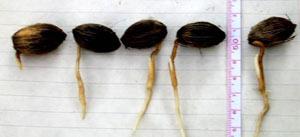
Queen Palm seeds 30 days of germination
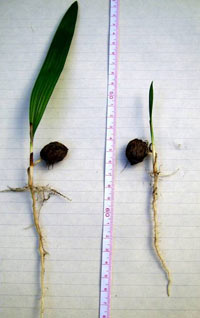
Queen Palm seeds 150 days of germination
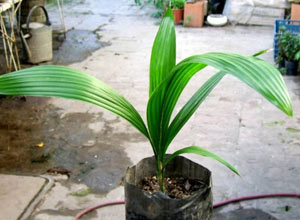
Queen Palm 23 months after germination
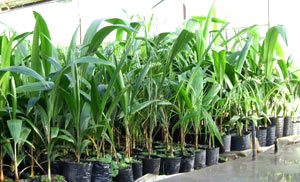
Landscaping With Queen Palm
The larger the Queen Palm grows, the more impressive it becomes as a landscape feature. Thanks to its fast and straightforward growth, it’s a common choice for both commercial and residential plantings.
This palm stands out beautifully on its own or when grouped with others. It’s versatile enough for lining streets, property boundaries, driveways, or fences. Moreover, it serves as an excellent backdrop for clusters of smaller plants or as an anchor for garden beds. However, it’s advisable to avoid planting it near a pool due to the messy fruits that may fall into the water.
Young Queen Palm specimens often display widely-spaced fronds extending almost to the base of the stem. If you plan to plant one near your house, ensure you leave about 10 feet of space for the leaves to expand. For row planting, allocate at least 5 feet or more between individual palms.
Occasionally, you may encounter groups of three Queen Palms growing together in the same location. When cultivated in this manner, they may vary in size and have slightly bending trunks. To achieve this look, you’ll need to grow them close together from the seedling stage.
Interestingly, the Queen Palm’s popularity can sometimes work against it. Many landscaping companies and homeowners tend to avoid using it simply because it’s so common. It’s not uncommon for novice gardeners to initially overplant their property with Queen Palms, only to remove some later on.
Growing Queen Palm Indoors
This palm doesn’t fare well as a houseplant. Its rapid growth rate necessitates frequent repotting. For instance, a 10-gallon plant will require relocation to a 15-gallon pot in just two years.
Failing to repot in a timely manner results in root occupation of the entire container, leading to a stressed and unhealthy appearance.
Additionally, the Queen Palm grows exceptionally tall at a rapid pace. While its growth is slower in a container compared to in the ground, it can quickly reach the ceiling when grown indoors.
Attempting to cultivate this tall plant in an outdoor container is also problematic, as strong winds can easily topple it over. Finding a container large enough to accommodate the necessary soil volume to support a Queen Palm can be challenging.
Another reason why it’s ill-suited as an indoor plant is its preference for abundant sunlight, ample air circulation, and higher humidity levels, which are difficult to replicate indoors.
Other Syagrus Varieties
Queen palm is part of Syagrus genus and has over 40 species. All of them are native to South America and the Caribbean.
- Syagrus amara (Overtop palm) – This is a salt-tolerant species with a broad canopy of coconut-like leaves and a tall slender trunk. It is native to the Lesser Antilles in Montserrat, Martinique, Guadeloupe, Dominica, and St. Lucia, making it the only Syagrus species not native to South America.
- Syagrus coronata (Ouricury palm, or licuri palm) – This is a smaller species with a thick trunk covered with visible leaf bases arranged in vertical or spiral rows.
Queen Palm Pictures
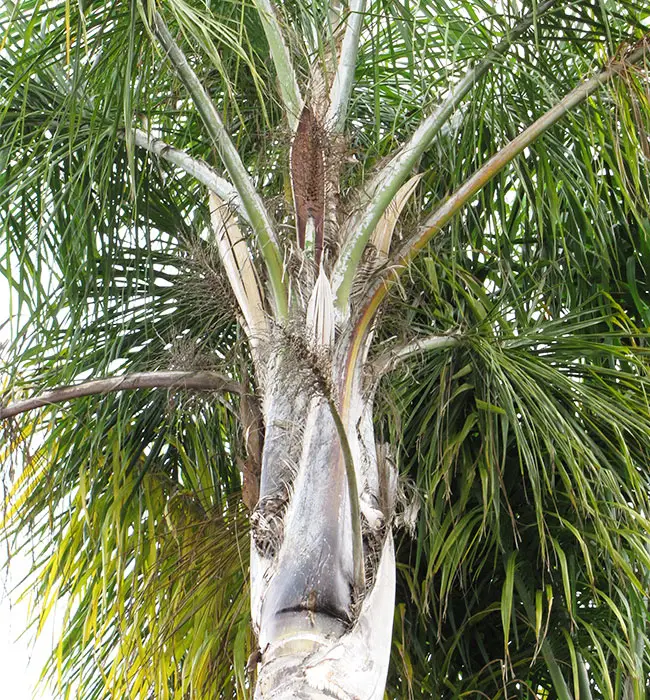
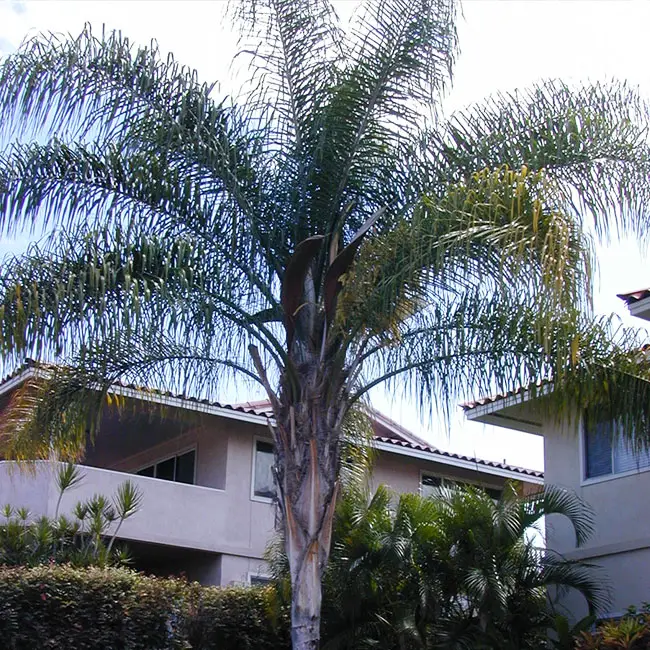
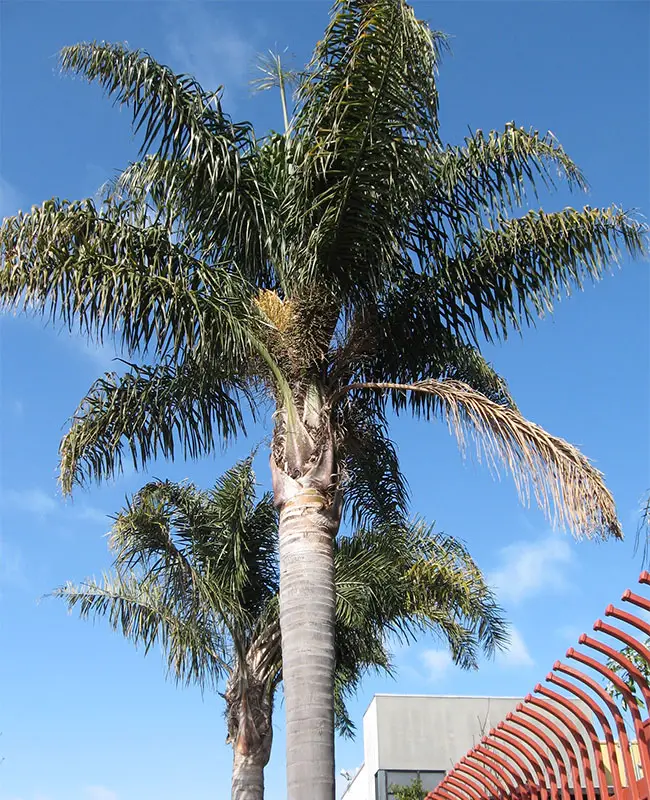
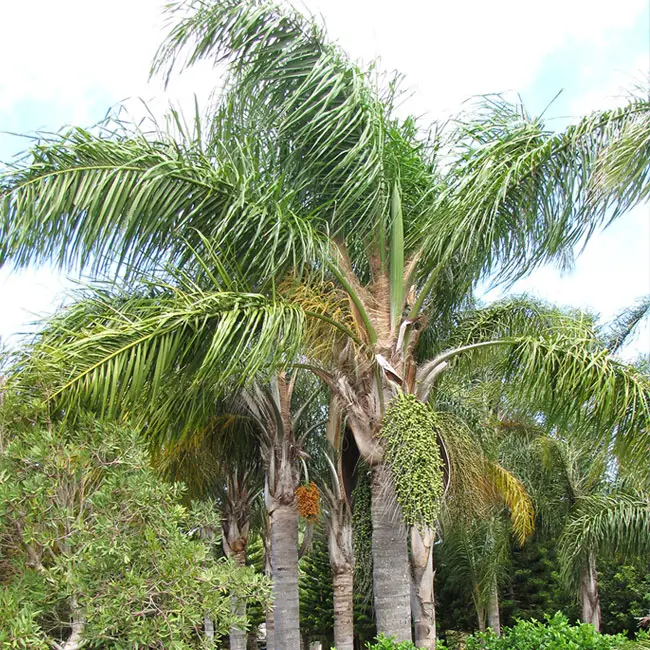
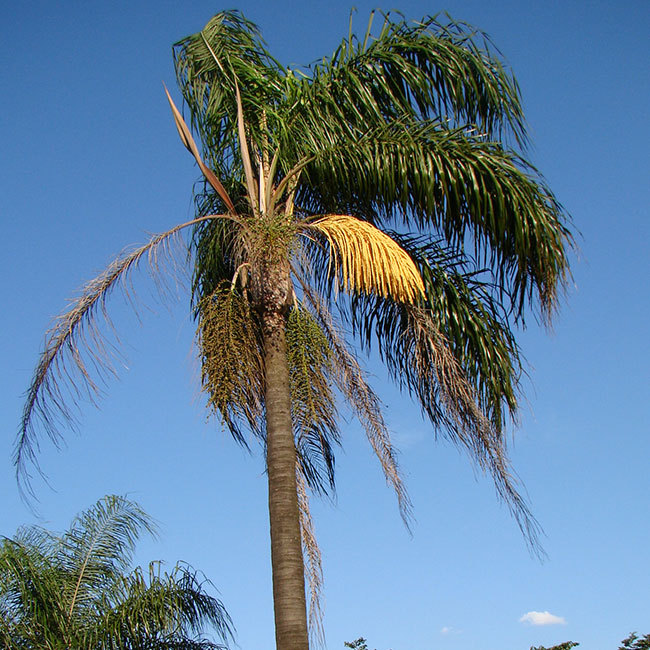
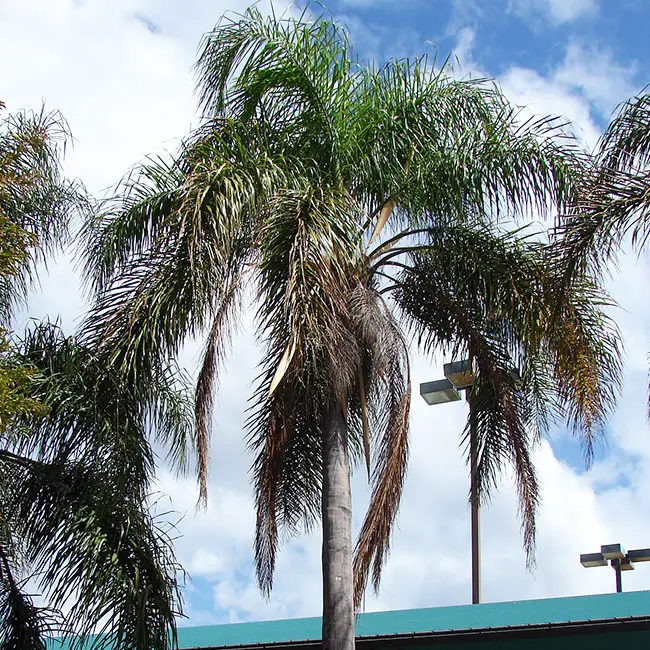
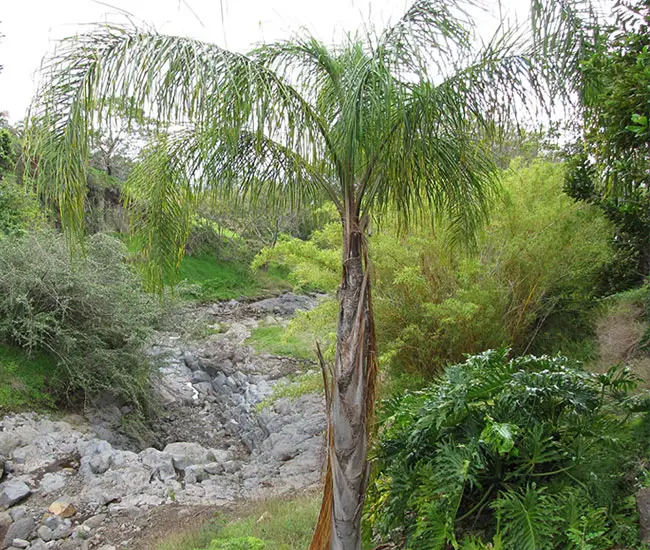
More information can be found on EDIS and Floridata sites.

what is the expected LIFE LENGTH of a QUEEN PALM ????
I would be grateful if you could tell me what the lifespan generally is for a queen palm thank you Wendy
I tried to pull my queen palm or my friend did and it broke off! It was my mother’s tree and I wanted to move it to my house, she passed away and she planted it. It has lots of the small roots on the outside bottom, will it live if I go ahead and plant it? Ty I can’t find any answers
My tree trimming service suggests 2 trimmings/year; spring and fall.
I see your fall recommendation and was wondering if a spring trimming, just before the hurricane season, is also needed.